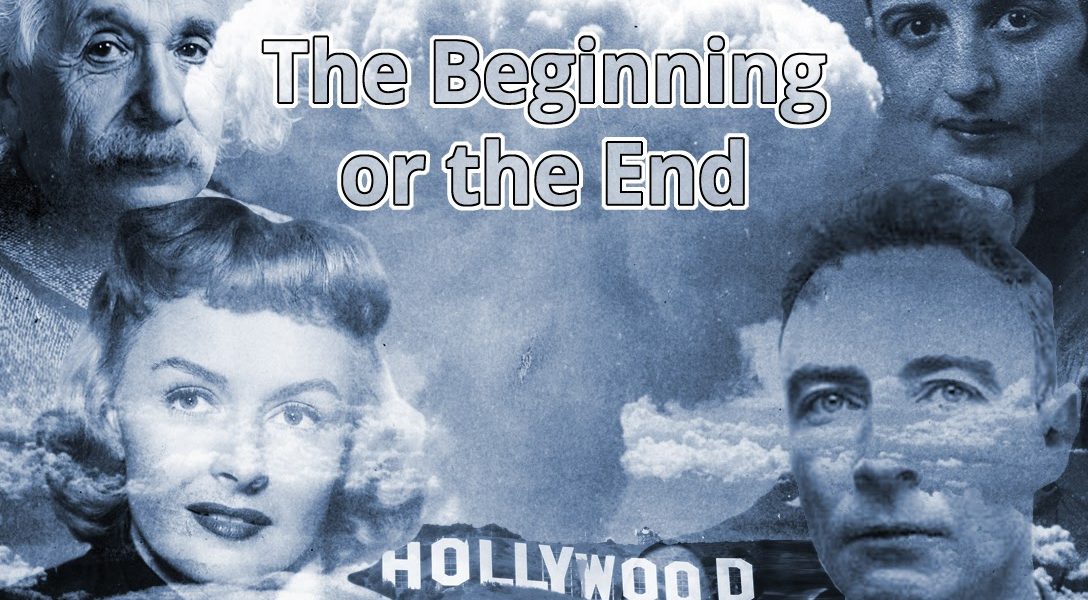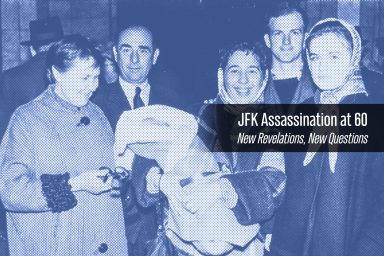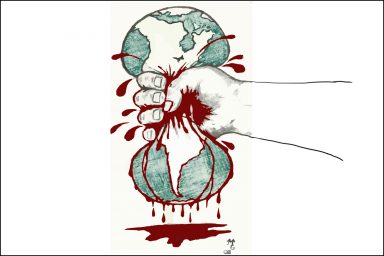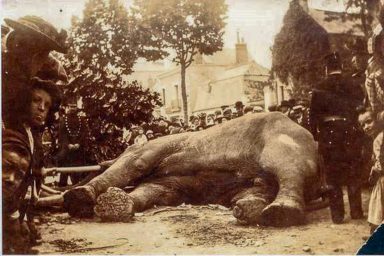Hollywood, Washington, and the Bomb
The Cinematic Aftershocks of Hiroshima and Nagasaki
The crazy but important story of what happens when the White House, the Pentagon, and the world’s greatest scientists are forced to work with Hollywood.
Yesterday marked the 75th anniversary of the bombing of Hiroshima and the dawn of the nuclear age. Given the current wave of disrespect for science and scientists, and the difficulty of secrecy, something like the Manhattan Project probably could not happen today. Maybe that alone is reason enough to look back.
Much has been written about the military, political, and moral implications of the bomb. Now Greg Mitchell, the author of The Beginning or the End: How Hollywood — and America — Learned to Stop Worrying and Love the Bomb, joins us to talk about the lesser-known cultural implications.
He shares the story of the very first Hollywood film about the bomb, MGM’s 1947 epic flop, The Beginning of the End. Originally intended to be a cautionary tale about the further use of nuclear weapons, it became pro-bomb propaganda. Proving the old adage from legendary film mogul Harry Cohn, who used to admonish his writers, “If you want to send a message, use Western Union.” (Long before Twitter.)
In this week’s WhoWhatWhy podcast, Mitchell talks about why Hollywood tackled the subject in the first place; how the 40-year-old Ayn Rand ended up writing a competing script about the bomb; and why the movie that finally emerged from the MGM film factory had so many laughably false facts.
In Mitchell’s telling, this Hollywood story features a fascinating cast of characters, from Donna Reed and the aforementioned Ayn Rand to Albert Einstein and J. Robert Oppenheimer.
Mitchell, the former editor of Nuclear Times and Editor and Publisher magazines, offers a satirical take on the sometimes frightening tale of what happens when the government and particularly the military get involved in trying to make a movie.



Click HERE to Download Mp3
Full Text Transcript:
As a service to our readers, we provide transcripts with our podcasts. We try to ensure that these transcripts do not include errors. However, due to time constraints, we are not always able to proofread them as closely as we would like. Should you spot any errors, we’d be grateful if you would notify us.
| Jeff Schechtman: | Welcome to the WhoWhatWhy podcast. I’m your host Jeff Schechtman.
The first atomic bomb test successfully exploded on July 16th, 1945, exactly 75 years ago. One of the observers at the time said it felt like being present at the creation. When William L. Laurence, the New York Times reporter embedded with the Manhattan Project, wasn’t allowed to tell his wife what he was doing when he went off for long periods of time, he would just tell her, “It’s Buck Rogers stuff.” And upon that first explosion, Laurence would write, “It was as though the earth had opened and the skies had split. One felt as though one were present at the moment of creation when God said, ‘Let there be light.'” It’s no accident then that anything so secret, so cinematic, so filled with great characters, even though filled with destruction, would be fodder for Hollywood. |
| Jeff Schechtman: | Louis B. Mayer in 1945 called the story of the atomic bomb one of the most important stories. But it’s no surprise that the culture of Washington, science, the Manhattan Project and the cowboys of Hollywood were not meant to coexist. The story of what happened is worthy of a Hollywood film onto itself. But it’s in fact the story that Greg Mitchell tells in his new book, The Beginning or the End. It is my pleasure to welcome Greg Mitchell, to talk about The Beginning or the End: How Hollywood – and America – Learned to Stop Worrying and Love the Bomb. |
| Jeff Schechtman: | Greg, thanks so much for joining us on the WhoWhatWhy podcast. |
| Greg Mitchell: | Thank you, Jeff. Happy to be here. |
| Jeff Schechtman: | How did you come to this story first of all? |
| Greg Mitchell: | Well, I’ve been involved, or some might say obsessed, with the atomic bombings since 1982 when I became the editor of Nuclear Times magazine which was the Bible of the anti-nuclear movement of the eighties. I then got a journalistic grant to go to Hiroshima in 1984 and I’ve written three books since and dozens of articles and probably thousands of blog posts. I found out about this movie actually at the Truman Library where I was researching another book and found that they had a whole file on it there, which very few people had ever seen. And it had this correspondence between Truman’s Press Secretary and MGM and the order from the White House to reshoot really the key scene in the movie where Truman explains his decision to use the bomb and other back and forth, which kind of blew my mind at this unprecedented White House intervention in a Hollywood movie. This was not war time, it was a year after the war ended and MGM caved completely. |
| Greg Mitchell: | So it kind of went from there, I kept… Wrote a little bit about it. I kind of did more research over the years and finally, a couple of years ago, decided to embark on a full treatment with much, much additional research at the Motion Picture Academy in LA with the Oppenheimer papers and Einstein papers and much more. |
| Jeff Schechtman: | And talk a little bit about the way this project evolved at MGM. Louis Mayer was excited about it. He thought that that was an important story. How did the project get started at the studio? |
| Greg Mitchell: | Well, it was kind of amazing in a way it… And this is really how the book starts. The actress, Donna Reed, who many will remember, got a letter out in Santa Monica from her high school chemistry teacher named Ed Tompkins. And he said he had disappeared and he had gone into the top secret Manhattan Project and he was writing her – now this was two months after Hiroshima – that could she urgently get Hollywood to make a major movie about the bomb warning the world of the dangers of going down the nuclear path, building more weapons, building bigger weapons, such as the H bomb, likelihood of an arms race with the Soviets, and just urging her to get a movie done. |
| Greg Mitchell: | She happened… Her husband happened to be a Hollywood agent. He soon was sitting down with Louis B. Mayer, as you said, Mayer jumped on it. They called it the most important movie he would ever make. And they started doing scripts and what the book really covers among other things is the… How this original idea for this movie warning the world from the scientist perspective was slowly transformed through numerous script revisions and cuts into what became pro bomb propaganda basically in the next year. And so I was able to get access to all the scripts and memos and so on and so forth. So I’m the first person to trace this transformation and the transformation based on going through the papers of Truman and General Groves, who was the head of the Manhattan Project. Able to see how the real reason for this was that both Groves and Truman were given script approval, again totally unprecedented. And they were allowed to read the scripts and force dozens of cuts and revisions and all in the direction of defending the bomb and defending the use of the bomb against Japan. |
| Jeff Schechtman: | I mean in that sense it is a classic Hollywood story because it didn’t happen all at once. It was one of those stories where there were revisions and revisions and a lots of cooks in the proverbial soup. And little by little, the project entirely morphed into something 180 degrees from where it started. |
| Greg Mitchell: | Yeah. Well that’s… Yeah, the story can be told now for the first time, based on seeing all the documents and scripts and so forth and… What’s revealing, I mean, the book is… I mean, it’s sort of entertaining and lively because it’s partly a Hollywood story, of course. And then it’s sort of more profound as we talk about the use of the bomb and the aftermath of the use of the bomb and so on and so forth. So it’s sort of a combination of that. But the details that come out are just what’s most revealing in some cases is the actual cuts or falsifications that were made in the script. And to mention just one thing, there are many people who still endorse the use of the bomb against Hiroshima, but who will then say in the next breath, “But Nagasaki was wrong,” or even “Nagasaki was a war crime.” |
| Greg Mitchell: | And so then the original scripts for the movie, they had plenty of scenes with the second bombing of Nagasaki and so on and… But as time went on, they cut every single mention of Nagasaki from the movie. So you could watch it tonight and have no idea there was even a second bomb. So it’s that kind of thing that is revealing in what is done. It’s not… This is not an academic book that lays out in 600 pages all the factual details of the bomb and everything else. It reveals what actually happened and the key issues and why America is still, I feel endangered by the fact we used the bomb 75 years ago, but it’s laid out in the narrative of these revisions in this Hollywood movie. |
| Jeff Schechtman: | Talk a little bit about who the writers were, how it evolved, who the players were inside MGM and with respect to the script. |
| Greg Mitchell: | Yeah, well, they hired Bob Considine, who was the author of Thirty Seconds Over Tokyo, famous World War II book. Also famous as a Hearst columnist. So he wrote kind of the lengthy first, the story for the movie. And then it was given for screenwriting to Frank Wead, who was a famous flyer, aviator, wartime and peacetime flyer. And he wrote the script and then plenty of cooks got involved in revising and so on and so forth. So the movie very quickly went from, as I’ve said, inspired by the scientist to being turned over to very much pro military, pro bomb writers. Louis B. Mayer, of course, was a very conservative Republican activist. Hollywood, contrary to what people may think today, was basically owned, run by conservatives then. |
| Greg Mitchell: | And so in some ways it’s not surprising that the movie got twisted over time. I think what’s more shocking probably to some is such close, detailed intervention by General Groves and by Truman. And so they just were allowed by MGM to have kind of a free hand with the script. I should also mention that this was… All this intrigue was… At the same time this was going on, I mean, there were two other very interesting things happening. One was that MGM had to get permissions from people they wanted to portray, had to get written contract releases to be portrayed. And so there’s a great subplot in the book about them chasing after Albert Einstein and J. Robert Oppenheimer and other famous scientists to get them to sign. |
| Greg Mitchell: | And then secondly, there was a competing movie from Paramount with the script by Ayn Rand no less. Most people don’t even know that Ayn Rand had written some screenplays. And so she was hired to write the really wild screenplay by Paramount. And so again… For the first time we sort of traced the development of that project and Ayn Rand’s script and her memos ultimately, partly because her script was so wacky, Paramount then sold out to MGM and so her movie never appeared. But she took this free time to write a little book called Atlas Shrugged. And so that’s how that movie developed. |
| Jeff Schechtman: | What was the Ayn Rand’s script like? |
| Greg Mitchell: | Well, it was… As one could imagine, it was very, I wouldn’t say pro-capitalist, it was also pro-individual in her view. The real heroes of the Manhattan Project were not Franklin Roosevelt for going down that path, the group of scientists working together. It was basically industry, American industry who helped fund it and the individual scientists. The individual like Oppenheimer as the individual scientists who worked on their own, pretty much on their own to make this happen. Of course, she ignored the fact that actually it was a collaborative effort. The fact that Oppenheimer was under the thumb of the military and Groves. But she had quite a fanciful. It’s much, much, too much to go into, but it was quite a wild screenplay. And in some ways it would be wonderful to see if it had been made to watch it and get a good chuckle over it. |
| Jeff Schechtman: | How involved was Truman and the people around him in overseeing this, keeping an eye on it? |
| Greg Mitchell: | Well, again, briefly the MGM kind of set this in motion when the producer and Donna Reed’s husband sat down with Truman in the Oval Office very early on. And he actually titled the movie The Beginning or The End which also the title of my book. He gave them sort of the title for the movie. And from the very beginning, they sort of signaled that he could veto anything he didn’t like in the movie. That then proceeded over time, scripts were sent to the White House. They ordered certain things taken out and then it culminates… Kind of the climax of the book in some ways is there was a screening in Washington in October of 1946 of the supposedly kind of finished film. And Truman’s Press Secretary saw it along with many others. And was just appalled that the way it treated Truman’s decision. It didn’t really explain why he dropped the bomb. It was more, he sort of made the decision and then it happened. |
| Greg Mitchell: | Which left kind… I suppose, left open to questions in many viewers about well was it right? Or what did it actually… Why… Was it necessary and so forth? So he had to… And then Truman, when he read it, then decided to order a complete retake, reshoot of that kind of costly scene. |
| Greg Mitchell: | And so they kind of marked up the script and it was then filmed by MGM, word for word after the White House approval. And it’s… If anyone dares to watch the movie today, it’s available streaming on DVD and Turner Classics, which owns it, airs it. I suspect it’ll be aired in the coming days for the 75th anniversary. It does lead up to the scene where Truman at Potsdam, three weeks before dropping the bomb, tells his secretary exactly why he was going to do it. And it was laid out the… What I call the Hiroshima narrative that still endures to this day, which is that, it was the only way to end the war. Saved a million American lives. There was nothing else we could do. The bomb is actually a great thing for America and so on. So that’s pretty incredible direct involvement in a movie, especially in peacetime. And so I’ve got excerpts from the script and of course all the letters, back and forth between MGM and the White house. And it’s a pretty amazing episode. |
| Jeff Schechtman: | One of the other things that it just brings into bold relief as the story unfolds is how insecure Truman and the administration was about the decision they had made. If they felt stronger about it or better about it, their actions here might have played out differently. |
| Greg Mitchell: | Yeah, it is surprising in some ways, because as I relayed in the book, there’s no question that after we dropped the bomb and the war ended and shortly after that most Americans, vast majority supported use of the bomb. And you can understand why after this horrible, long and deadly war for the war to end, however it ended, was certainly something to celebrate. So the bomb was very much tied to that. And there are historians debate to this day, whether the bomb was the main cause for the Japanese surrender or was Russia’s sudden entry into the war. Whether it was the USA signaling we would allow them to keep their emperor. There are at least three major factors there. But nonetheless, there’s no question that people endorsed the view and that that remained. |
| Greg Mitchell: | But nevertheless the White House and the people who made the bomb, certainly Oppenheimer and others were extremely nervous about how that decision would be viewed. Now, you might say maybe they felt some guilt, possibly, or they felt the decision really wasn’t necessary and that this would kind of be disclosed or people would get this inkling. It’s a moral shock. Now, most people were able to overcome that. But when you kill 200,000 civilians within three days, it’s something to be… Something to weigh on you. And so I think there was that fear. |
| Greg Mitchell: | So the… All these revisions in the movie are interesting because we do see even down to the details of… They couldn’t… They didn’t want to show the bombers heading for Hiroshima as what actually happened. They flew there, they were undetected, beautiful morning, no opposition from the Japanese, dropped the bomb, flew away. Instead they have to show that it was somehow risky and brave and might not have happened. So they first introduced in the script that there’s some anti-aircraft fire and flak, and then it became heavy flak. And then ultimately there was a script with the Japanese fighters in the distance ready to fire on them. So they couldn’t just show it the way it happened. They had to build up the American bravery. And I could give you 10 more examples in that vein where this narrative had to be sustained even if things were falsified. |
| Jeff Schechtman: | How did the scientists, Oppenheimer, Einstein, et cetera, how did they feel about the movie and the project? |
| Greg Mitchell: | They’re one of the real subplots because of this MGM chasing after the Einstein and Leo Szilard who was one of the, again, one of the key scientists, Oppenheimer, chasing after them to get their permissions. And the scientists were all… The scientists were extremely opposed to being involved with the movie at first. They either just in general, they knew coming from MGM, it would probably be a schlocky, a Hollywood Epic or they just felt that the subject is too sensitive to be depicted and they felt conflicted feelings. And so MGM chased them. Ultimately they wore down Einstein and this Szilard and then there’s quite a bit about the always fascinating figure of Oppenheimer and how in his usual way, he was very conflicted. And then there’s a scene where the movies’ producer comes to his home in Berkeley and quite a detailed record of that and how Oppenheimer finally caved and then made fun. |
| Greg Mitchell: | I have a full disclosure of Oppenheimer then mocking the movie and making fun of the whole thing. And so it was kind of classic Oppenheimer, but all of those scientists ultimately signed this release. And so they are depicted in the movie rather poorly, but they are depicted. The other fascinating thing is that each of those three very, very famous scientists I just mentioned were also under FBI surveillance during that year. Each of them was suspected by J. Edgar Hoover of communist connections or communist sympathy. Oppenheimer was most vulnerable because his wife was a former communist, the brother was a former communist. His mistress who had recently killed herself was a former communist. And so the FBI had extensive surveillance of these three men. Oppenheimer’s phone was tapped. In fact I have sort of published for the first time, a lengthy transcript of Oppenheimer talking to his wife from across the country about this movie, making fun of this movie and so on, all captured on FBI wiretap. |
| Greg Mitchell: | So like I said, there’s a lot going on. This movie is set in 1946, which is a real turning point for postwar America. The Cold War really started, secrecy began. The Hollywood blacklist began. We really were… The first atomic tests in the Pacific were carried out, the path to making the H-bomb was developed. So this book is really a full probing of this incredible turning point year. And again the movie somehow serves as a great vehicle to study these things. |
| Jeff Schechtman: | The movie as a vehicle and the story that you tell is far more interesting than the movie itself. Talk about the fact that the movie was such a flop. |
| Greg Mitchell: | Well one reason it was a flop and it wasn’t a total flop. I think people and of course it’s fun to call it a bomb, bombed at the box office and all that. But it got mixed reviews, including The New York Times and then a lot of other places. And at the box office, it didn’t do well and it lost money, it’s true. But it was not a complete failure, but in any case, one reason for it was the fact that the MGM was so open to the revisions and was continually rewriting. |
| Greg Mitchell: | And then of course, as I mentioned, this ultimate reshoot ordered by Truman delayed the release of the movie by months. And so when it finally came out, a year and a half had passed since the bombing and back in those days, Hollywood could really churn these out. So more than a year and a half after Hiroshima, the movie came out. And so it was difficult to overcome that. And it’s not a good movie because it’s so cobbled together. And there’s elements of… There’s like a fake newsreel in it. Two love stories are grafted into it. None of the stars were the A level, ultimately. So maybe it was kind of doomed basically by MGM, maybe losing faith and turning it over to Washington. |
| Jeff Schechtman: | As you look at the period that came later in the fifties and even into the early sixties a little bit, what is your sense of how Hollywood has dealt with the bomb, with nuclear issues, et cetera? |
| Greg Mitchell: | Right. Well, the amazing thing is while most people would say, “Oh, God, there’s been so many movies with the bomb.” And of course, many famous ones such as Fail Safe, and Dr. Strangelove and many science fiction movies that in a way warned about nuclear radiation and things all the… Even Godzilla. |
| Jeff Schechtman: | On the Beach. |
| Greg Mitchell: | Yeah, On the Beach is a great, great example. Maybe not so many since 1960s, I have to say, but in 75 years there have only been three movies from Hollywood about the making and the use of the bomb. There was this movie, The Beginning or The End. About five years after that, MGM did a kind of sequel, even using some of the same footage portraying the pilot who dropped the bomb on Hiroshima, Paul Tibbets played by Robert Taylor. And then not a single movie for 37 years until Roland Joffe, who directed The Killing Fields and other movies, made a movie called Fat Man and Little boy, which also did poorly. He had intended it as kind of an anti-bomb movie, but then he made the fatal mistake of casting Paul Newman as Leslie Groves and a total unknown as Oppenheimer. So this was supposed to be a great dual between the two of them. And he’s got an unknown on one side and Paul Newman as General Grove so that movie was also doomed and there hasn’t been one since then, 30 years. |
| Greg Mitchell: | So I think that speaks for itself: three movies in 75 years on one of the, if not the most important, single event of the 20th century. And even the movies that did tackle it, did it in a kind of sideways manner. |
| Jeff Schechtman: | And yet what’s interesting is how many people have a sense of the Manhattan Project and what happened and who the players were from what limited movies there were. |
| Greg Mitchell: | I mean, there’ve been numerous documentaries, especially about Oppenheimer and History Channel and everything else. There’s no question you can find documentaries on this, the specials there maybe even this year, there may be a network special or two, that kind of thing. But it’s all based on facts, not drama, not Hollywood drama, big budget, big audience kind of thing. So again, that’s very revealing and I think the… And there’s been much, much more attention on the making of the bomb than on the using of the bomb. And as I wrote a book with Robert Jay Lifton called Hiroshima in America and which we call “Hiroshima: America’s Raw Nerve”. And I think that’s… They don’t really want to depict what happened on the ground. They want to show the making of the bomb and the great scientific achievement, and then they want to show the end of the war. |
| Greg Mitchell: | But what happened on the ground is very tough for Americans to handle because as I said, there are probably at least 200,000 killed, maybe more than that. And 90% of them were civilians. In fact, in the case of Nagasaki, they’ve only been able to identify maybe 150 military personnel. So yeah, maybe 90,000 civilians and 150 military. Now that’s difficult to depict. I mean, it’s one thing for Hollywood to show other war crimes or terrible war aftermaths and civilian carnage that are committed by other nations. But it’s very, very difficult to show that we did it. And of course there is a great historical debate. Could it have been avoided? Should it have been avoided? But nevertheless, we did it and that can’t be taken away so… But America doesn’t really want to face that and have sort of an honest debate about it. |
| Jeff Schechtman: | Greg Mitchell, his book is The Beginning or The End: How Hollywood – and America – Learned to Stop Worrying and Love the Bomb. |
| Jeff Schechtman: | Greg, I thank you so much for spending time with us here on the WhoWhatWhy podcast. |
| Greg Mitchell: | Jeff, anytime. Thank you. |
| Jeff Schechtman: | Thank you. |
| Jeff Schechtman: | And thank you for listening and for joining us here on radio WhoWhatWhy. I hope you join us next week for another radio WhoWhatWhy podcast. I’m Jeff Schechtman. |
| Jeff Schechtman: | If you liked this podcast, please feel free to share and help others find it by rating and reviewing it on iTunes. You can also support this podcast and all the work we do by going to whowhatwhy.org/donate. |
Related front page panorama photo credit: Adapted by WhoWhatWhy from The New Press, National Archives / Wikimedia, and US Air Force / Wikimedia.



